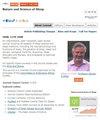阻塞性睡眠呼吸暂停与骨矿物质密度的因果关系及体重指数的作用
IF 3
2区 医学
Q2 CLINICAL NEUROLOGY
引用次数: 0
摘要
背景:关于阻塞性睡眠呼吸暂停(OSA)与骨矿物质密度(BMD)之间的关系,观察性研究得出了相互矛盾的证据。由于确切的因果推论仍无定论,我们进行了双样本孟德尔随机化(MR)研究,以确定 OSA 与 BMD 之间的因果关系:从芬兰基因研究中提取了与 OSA 相关的单核苷酸多态性。从公开的 IEU GWAS 数据库中获取了在不同年龄或骨骼部位测量的 10 个 BMD 的汇总统计数据。研究选择了反方差加权法(IVW)作为主要分析方法,并结合几种敏感性分析来评估结果的稳健性。研究设计包括双样本 MR 和网络 MR:我们的主要磁共振分析显示,遗传预测的 OSA 与前臂 BMD(β=0.24,95% 置信区间 [CI]:0.06- 0.41,p = 0.009)和足跟 BMD(β=0.10,95% CI = 0.02-0.18,p = 0.018)的增加呈正相关,而在 OSA 与全身 BMD、腰椎 BMD 或股骨颈 BMD 之间未观察到显著的因果关系(所有 p 均为 0.05)。网络MR表明,OSA可能是BMI对前臂BMD和足跟BMD影响的中介因素,估计中介部分分别为73%和84%:我们的研究结果支持了遗传预测的 OSA 与前臂 BMD 和足跟 BMD 增加之间的因果关系。此外,我们的研究结果表明,OSA 可能对 BMI 对 BMD 的影响起到了中介作用。本文章由计算机程序翻译,如有差异,请以英文原文为准。
Causal Relationship of Obstructive Sleep Apnea with Bone Mineral Density and the Role of BMI
Background: Observational studies have yielded conflicting evidence concerning the relationships between obstructive sleep apnea (OSA) and bone mineral density (BMD). As the exact causal inferences remain inconclusive, we conducted a two-sample Mendelian randomization (MR) to identify the causal associations between OSA and BMD.
Methods: Single-nucleotide polymorphisms associated with OSA were extracted from the FinnGen study. Summary statistics for 10 BMD measured at different age or skeletal sites were obtained from the publicly available IEU GWAS database. Inverse-variance weighted (IVW) method was chosen as the primary analysis, combined with several sensitivity analyses to evaluate the robustness of results. The study design included two-sample MR and network MR.
Results: Our primary MR analysis revealed that genetically predicted OSA was positively linked to increased forearm BMD (β = 0.24, 95% confidence interval [CI]: 0.06– 0.41, p = 0.009) and heel BMD (β=0.10, 95% CI = 0.02– 0.18, p = 0.018), while no significant causal relationships were observed between OSA and total body BMD, lumbar spine BMD, or femoral neck BMD (all p > 0.05). Network MR suggests that OSA might act as a mediating factor in the effect of BMI on forearm BMD and heel BMD, with a mediated portion estimated at 73% and 84%, respectively.
Conclusion: Our findings provide support for a causal relationship between genetically predicted OSA and increased forearm BMD and heel BMD. Furthermore, our results suggest that OSA may play a role in mediating the influence of BMI on BMD.
Methods: Single-nucleotide polymorphisms associated with OSA were extracted from the FinnGen study. Summary statistics for 10 BMD measured at different age or skeletal sites were obtained from the publicly available IEU GWAS database. Inverse-variance weighted (IVW) method was chosen as the primary analysis, combined with several sensitivity analyses to evaluate the robustness of results. The study design included two-sample MR and network MR.
Results: Our primary MR analysis revealed that genetically predicted OSA was positively linked to increased forearm BMD (β = 0.24, 95% confidence interval [CI]: 0.06– 0.41, p = 0.009) and heel BMD (β=0.10, 95% CI = 0.02– 0.18, p = 0.018), while no significant causal relationships were observed between OSA and total body BMD, lumbar spine BMD, or femoral neck BMD (all p > 0.05). Network MR suggests that OSA might act as a mediating factor in the effect of BMI on forearm BMD and heel BMD, with a mediated portion estimated at 73% and 84%, respectively.
Conclusion: Our findings provide support for a causal relationship between genetically predicted OSA and increased forearm BMD and heel BMD. Furthermore, our results suggest that OSA may play a role in mediating the influence of BMI on BMD.
求助全文
通过发布文献求助,成功后即可免费获取论文全文。
去求助
来源期刊

Nature and Science of Sleep
Neuroscience-Behavioral Neuroscience
CiteScore
5.70
自引率
5.90%
发文量
245
审稿时长
16 weeks
期刊介绍:
Nature and Science of Sleep is an international, peer-reviewed, open access journal covering all aspects of sleep science and sleep medicine, including the neurophysiology and functions of sleep, the genetics of sleep, sleep and society, biological rhythms, dreaming, sleep disorders and therapy, and strategies to optimize healthy sleep.
Specific topics covered in the journal include:
The functions of sleep in humans and other animals
Physiological and neurophysiological changes with sleep
The genetics of sleep and sleep differences
The neurotransmitters, receptors and pathways involved in controlling both sleep and wakefulness
Behavioral and pharmacological interventions aimed at improving sleep, and improving wakefulness
Sleep changes with development and with age
Sleep and reproduction (e.g., changes across the menstrual cycle, with pregnancy and menopause)
The science and nature of dreams
Sleep disorders
Impact of sleep and sleep disorders on health, daytime function and quality of life
Sleep problems secondary to clinical disorders
Interaction of society with sleep (e.g., consequences of shift work, occupational health, public health)
The microbiome and sleep
Chronotherapy
Impact of circadian rhythms on sleep, physiology, cognition and health
Mechanisms controlling circadian rhythms, centrally and peripherally
Impact of circadian rhythm disruptions (including night shift work, jet lag and social jet lag) on sleep, physiology, cognition and health
Behavioral and pharmacological interventions aimed at reducing adverse effects of circadian-related sleep disruption
Assessment of technologies and biomarkers for measuring sleep and/or circadian rhythms
Epigenetic markers of sleep or circadian disruption.
 求助内容:
求助内容: 应助结果提醒方式:
应助结果提醒方式:


